The West Coast Enviroschools approach to waste reduction involves a facilitated session at school where students survey and evaluate their current waste practices and programmes, and then strategise ways to take action on issues that are priorities for their school community. The process we guide students through is based on the Enviroschools Action Learning Cycle (ALC) stages:
- Identifying the Current Situation: completing a Zero Waste Survey (based on the Enviroschools 4 key areas of school/centre life) & Waste Walk Through (detailed below)
- Exploring Alternatives: discussion through questions based on the ALC and looking at best practice examples from our network
- Taking Action: utlilising questions from the ALC and completing an action planner
- Reflecting on Change: scheduling a check-in after 3-6 months to see how they are going with their actions, and what further support they may need.

Hokitika Primary Taiao warriors completing the action planning.
After completing the Review with the group, our facilitator will collate all the information, prepare a report and share this with the group. The results are then shared more widely in a variety of ways e.g. school assemblies, newsletters, school/centre social media.
“It was interesting and fun. I love giving ideas and advice” – Melah, Waste Audit Team – Taiao Warriors of Hokitika Primary School
“I feel way more confident about what to do next.” – Nikoya, Waste Audit Team – Taiao Warriors of Hokitika Primary School
Children and young people lead the process, with strong support from adults. Students lead the ‘Waste Walk Through’, inspecting all waste systems onsite, then explore ways to support the whole school/centre with further reduction of waste. Practical actions that will target current issues are prioritised, with realistic timeframes and resources required highlighted.
“The Waste Review is a really useful tool that requires us to pause and think critically about our school approach to managing waste. Students are empowered to take sustainable actions and the process helps to deepen our understanding about the issues of waste.” – Caitlin Reid, lead Enviroschools teacher at Hokitika Primary School.
Existing waste minimisation practices are maintained, and schools are branching into new actions. Here is a sample of local innovative actions based on the waste hierarchy.
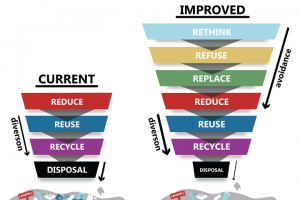
Infographic: Prime Minister’s Chief Advisor, Rethinking Plastics in Aotearoa New Zealand Key Messages, Auckland 2020. pp.18
- Rethink – Designing products out of compostable materials; purchasing decisions to reduce packaging and other waste
- Refuse – Refusing glitter, common in schools art rooms, and making oat glitter
- Replace – Saying no to disposable crockery and sourcing reusable items for school events and meetings
- Reduce – Composting paper hand towels and food scraps to divert waste from landfill
- Reuse – Building vegetable beds out of donated materials
- Recycle – Fine-tuning recycling systems as issues arise
“It’s really important to us to refuse and reduce waste where we can so each year we do a waste audit to see how we are going and what changes we need to make.” – Greta Thompson, Year 6
“I love doing [the waste review] because I get to choose actions that are going to help our school look after the environment by making less rubbish” – Melah Allen, Year 6
The Review results show that all participating Enviroschools continue to reduce waste in an increasing range of ways. An example of an increase in actions would be Kidsfirst Hokitika, going from 17 to 29 actions in the last review (2019). In 2019, the average number of waste minimisation actions implemented by each school/centre on the West Coast was 24.
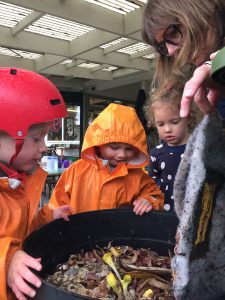
Kidsfirst Karoro Kindergarten tamariki check out their worm farm.
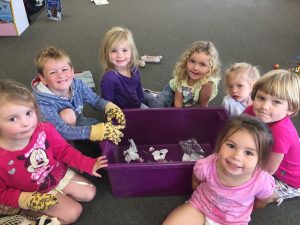
Harper Park Early Learning Centre handy helpers waste warriors.
This facilitated approach and reflective questioning empowers students to build an understanding of the issue and then positively contribute to solutions. Because this is an annual process, change over time is measured. A regional approach has allowed us to gain a bigger picture of the issues facing our schools/centres and communities and to find ways to support our network to continue and refine their waste reduction.
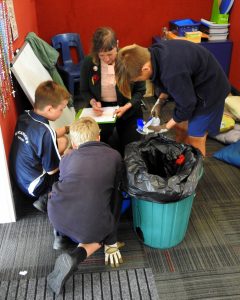
West Coast Enviroschools facilitator, Sarah, inspects bins with St Canice’s School students.
“On Tuesday we went around all the rooms in the school with Sarah, the Enviroschools Facilitator. Our job was to check if all the classrooms had the right bins for recycling, scrap paper and food scraps. One of our jobs was to sort through the rubbish bins and see what children and teachers had put in. We found that in every classroom, the bins contained at least 3 chippie bags, other plastic bags, gladwrap and yoghurt containers. And this was only after morning tea! We did find that the teachers only had one bin in the staffroom and everything went into it. We think the teachers need a food scrap bucket in the staffroom too, especially for the tea bags and the lemon skins. Next term, we hope to have Nude Food days at least every second week because we were shocked at the amount of wrappers and plastic in the bins. Thanks to Sarah, we learnt heaps about plastic and all the chemicals in it.” – written by St Canice’s Envirogroup kids
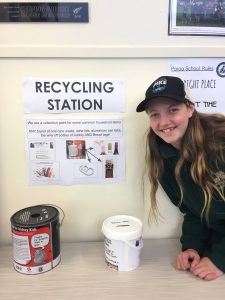
Paroa School is providing options for community recycling.

Kidsfitst Hokitika Kindergarten have been raising awareness with whānau.
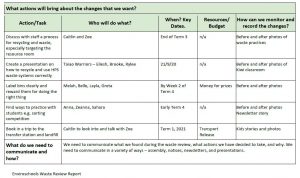
An example of the Action planning part of the review.
Banner image: Reefton Area School student-designed and led waste station.
